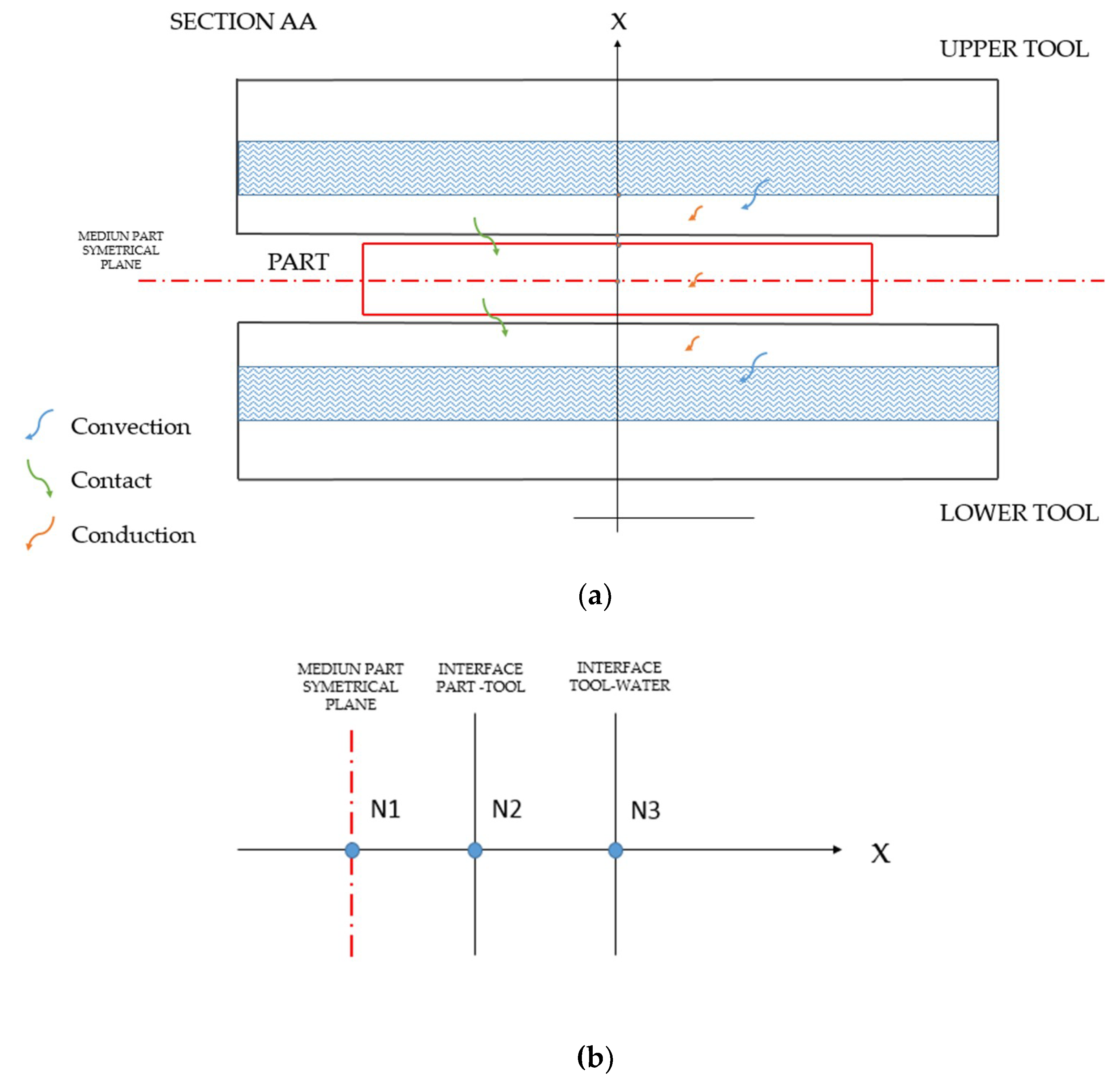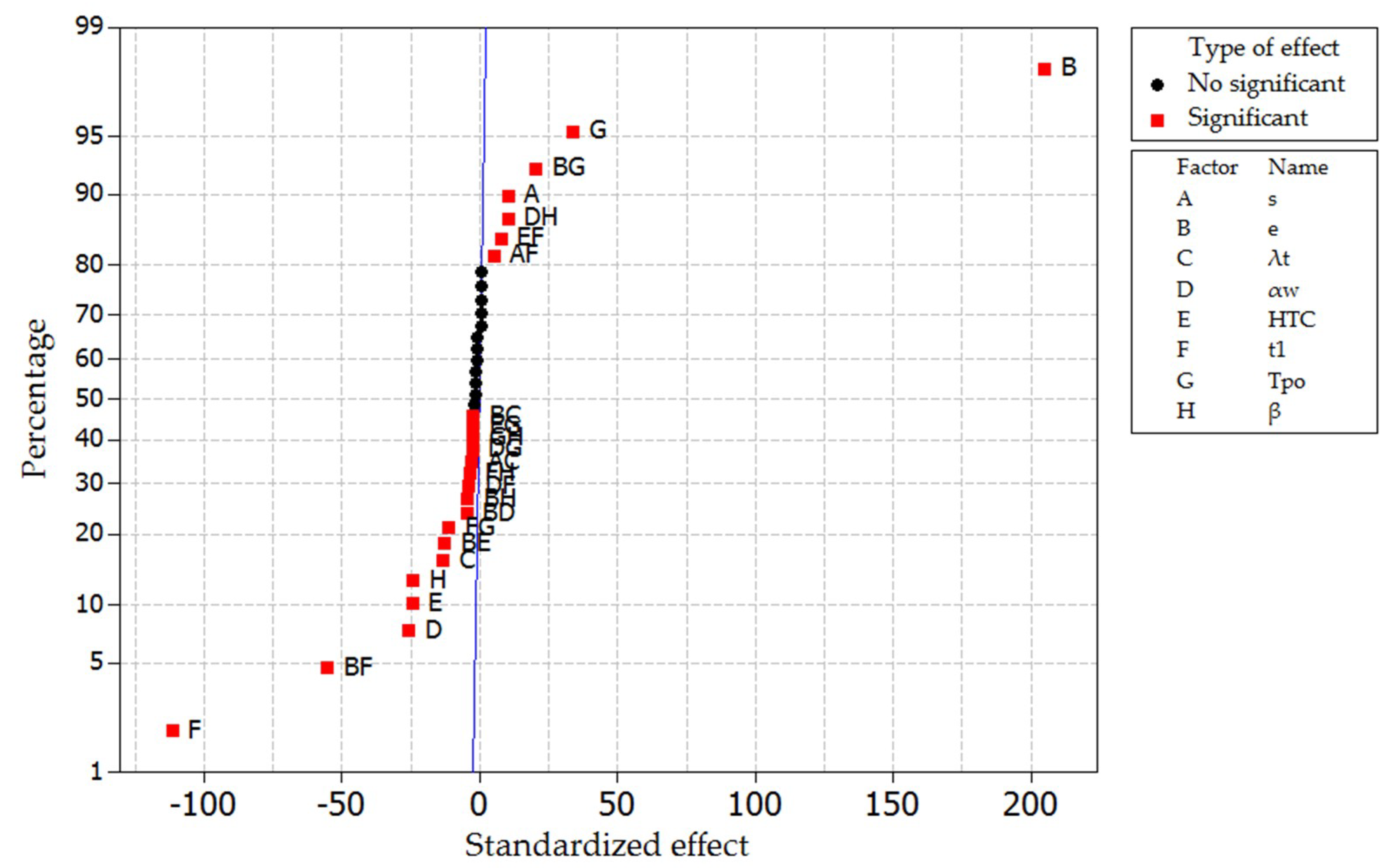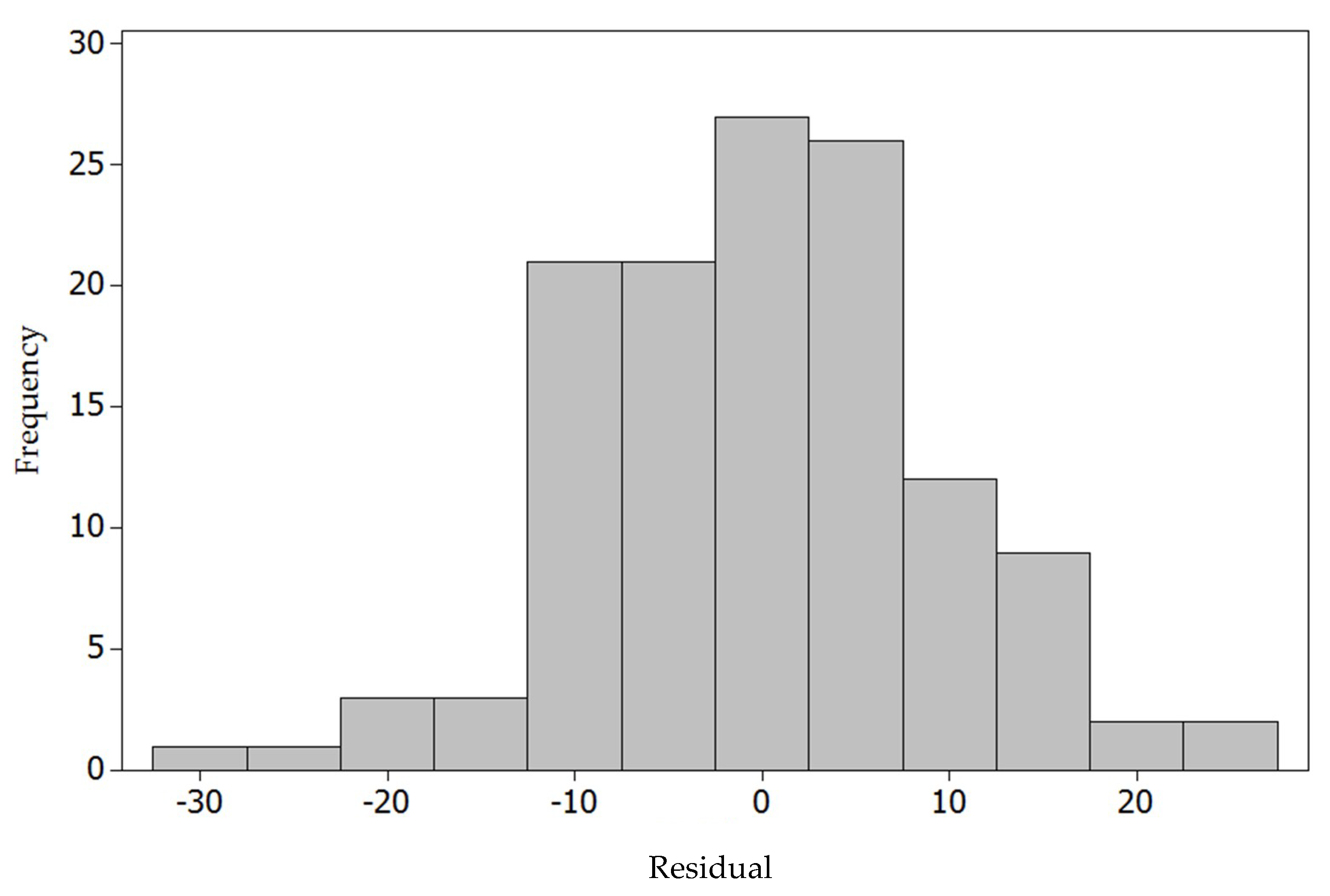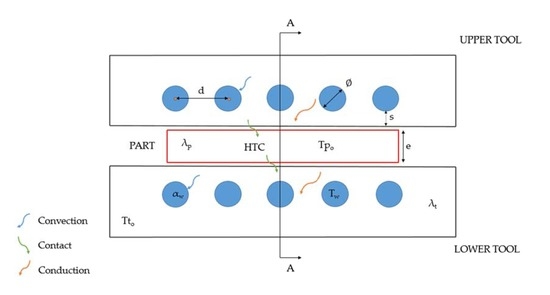A Quick Cycle Time Sensitivity Analysis of Boron Steel Hot Stamping
Abstract
:1. Introduction
2. Materials and Methods
2.1. Cycle Time: Cooling Time (t1)
2.2. Part Material: Thickness (e) and Part Initial Temperature before Forming (Tpo)
2.3. Cooling Design: Distance from the Cooling Channels to the Tool Surface (s) and Reduction Factor (β)
2.4. Heat Transfer Contact Factor (HTC)
2.5. Hot Stamping Tool: Material Conductivity (λt)
2.6. Cooling Water: Water Convection Factor (αw)
2.7. Iterative One-Dimensional Heat Transfer Model
2.8. Design of Experiments
2.9. Validation Testing
- -
- Test sample: 80 mm × 90 mm samples of a 3 mm thick (e), AlSi-coated 22MnB5 steel were conditioned by means of electric discharge machining (EDM). A 1.15 mm diameter × 30 mm deep hole was machined in the center of the sheet thickness and aligned with the axis of symmetry corresponding to the 90 mm long side of the samples. An AISI 316L sheathed Type K thermocouple 1 mm in diameter was inserted into the EDM hole up to the point where the tip of the thermocouple touched the bottom of the hole. The thermocouple was fixed in this position using a refractory adhesive.
- -
- Test tooling: a flat stamping tool with a 150 mm × 150 mm active surface. A QRO90 material in the quench and tempered condition (52 HRC, material conductivity (λt) = 33 W/m·K) was selected for the tools. The cooling channel design followed the “10–10–10” rule: 10 mm channel diameter (∅), 10 mm distance to surface (s), and 10 mm distance between channels (d).
- -
- Cooling intake conditions: water temperature (Tw) of 20 °C was used with a flow rate of 20 L per min to obtain a maximum water convection factor (αw) of 15,000 W/m2·K; a lower factor can be obtained by regulating the water intake valve closure. Regulation down to 7500 W per m2·K was performed.
- -
- Press: the tests were performed in an MTS 180 hydraulic press (Materials Testing System, Eden Prairie, MN, USA). A four-step press stroke of 17 mm was programmed:
- ○
- Step 1: rapid approximation speed of 34 mm/s up to a preload of 500 N.
- ○
- Step 2: load increase up to 10 MPa at a rate of 1 mm/s to obtain an HTC of 2500 W/m2·K.
- ○
- Step 3: 10 s of cooling time with fixed position control.
- ○
- Step 4: sample release and a 34 mm/s rate to initial press position.
- -
- Tool temperature (Tt) measurement: combined thermography and direct-contact Type K thermocouples were used immediately after removing the press hardened sheet sample from the tool.
- -
- Heating and transfer time: austenitizing of the 22MnB5 samples was performed in a N7/H furnace (Nabertherm GmbH, Bahnhofstr. 20, Lilienthal, Germany) at a setpoint temperature of 900 °C. The furnace was preheated to this temperature, and samples were introduced for 300 s. The part initial temperature prior to forming (Tpo) lies between 820 °C and 850 °C. Furthermore, after this dwell time, the austenitized samples were manually transferred to the press in ~4 s, i.e., from the opening of the furnace to the delivery of the sample inside the tooling. The final part was transferred from the tool to the conveyor in ~6 s. The total handling time (t2) was ~10 s.
- -
- Cooling time (t1): 10 s.
- -
- The test is performed with the same parameters for 10 cycles to achieve steady-state conditions equivalent to industrial production.
3. Results
3.1. Effects and Interaction Grade 2 of the Design of Experiments Factors
3.2. Selected Effects and Interaction Grade 2 of the Design of Experiments Factors
3.3. Equation for Calculating Cooling Time (t1)
3.4. Test Validation
4. Conclusions
- -
- The proposed simplified formula offers excellent fitting with experimental results in interpolation scenarios.
- -
- Provided that most industrial hot stamping processes are contained in the process window enclosed by the DOE variables, the proposed simplified formula can be applied extensively for a first approach to cycle-time calculation.
Author Contributions
Funding
Acknowledgments
Conflicts of Interest
Abbreviations
| e | Part thickness |
| ∅ | Water channel diameter |
| s | Distance from channel to tool contact surface |
| d | Distance between the center of the channels |
| t1 | Cooling time |
| t2 | Handling time |
| Tpo | Part initial temperature |
| Tto | Tool initial temperature |
| HTC | Heat transfer contact factor |
| αw | Water convection factor |
| λt | Tool thermal conductivity |
| λp | Part thermal conductivity |
| Tp | Part temperature |
| Cpp | Part specific heat |
| ρp | Part density |
| Cpt | Tool specific heat |
| ρt | Tool density |
| Tw | Tool water temperature |
| Pr | Prandtl number |
| Re | Reynolds number |
| Nu | Nusselt number |
| Cpw | Water specific heat |
| µ | Dynamic viscosity |
| ρw | Water density |
| k | Water thermal conductivity |
| v | Velocity |
| Δt | Time increment |
| cond | Rate of conduction heat |
| cont | Rate of contact heat |
| conv | Rate of convection heat |
| gen | Rate of generation heat inside the element |
| ΔE element | Rate of change of the energy content of the element |
| Tipt1i | Inside part temperature associated with t1 corresponding to cycle number i |
| Topt1i | Outside part temperature associated with t1 corresponding to cycle number i |
| Ttt1i | Tool temperature associated with t1 corresponding to cycle i |
| Ttcht1i | Tool cooling channel temperature associated with t1 corresponding to cycle i |
| Ttt2i | Tool temperature associated with t2 corresponding to cycle i |
| Ttcht2i | Tool cooling channel temperature associated with t2 corresponding to cycle i |
| Ttt2i−1 | Tool temperature associated with t2 corresponding to cycle i–1 |
| Ttcht2i−1 | Tool cooling channel temperature associated with t2 corresponding to cycle i–1 |
References
- Karbasian, H.; Tekkaya, A.E. A review on hot stamping. J. Mater. Process. Technol. 2010, 210, 2103–2118. [Google Scholar] [CrossRef]
- Mori, K.; Bariani, P.F.; Behrens, B.-A.; Brosius, A.; Bruschi, S.; Maeno, T.; Merklein, M.; Yanagimoto, J. Hot stamping of ultra-high strength steel parts. CIRP Ann. Manuf. Techn. 2017, 66, 755–777. [Google Scholar] [CrossRef]
- Cortina, M.; Arrizubieta, J.I.; Calleja, A.; Ukar, E.; Alberdi, A. Case study to illustrate the potential of conformal cooling channels for hot stamping dies manufactured using hybrid process of laser metal deposition (LMD) and milling. Metals 2018, 8, 102. [Google Scholar] [CrossRef]
- He, B.; Ying, L.; Li, X.; Hu, P. Optimal design of longitudinal conformal cooling channels in hot stamping tools. Appl. Therm. Eng. 2016, 106, 1176–1189. [Google Scholar] [CrossRef]
- Lee, S.H.; Park, J.; Park, K.; Kweon, D.K.; Lee, H.; Yang, D.; Park, H.; Kim, J. A study on the cooling performance of newly developed slice die in the hot press forming process. Metals 2018, 8, 947. [Google Scholar] [CrossRef]
- Gorriño, A.; Angulo, C.; Muro, M.; Izaga, J. Investigation of thermal and mechanical properties of quenchable high-strength steels in hot stamping. Metall. Mater. Trans. B 2016, 47, 1527–1531. [Google Scholar] [CrossRef]
- Caron, E.J.F.R.; Daun, K.J.; Wells, M.A. Experimental heat transfer coefficient measurements during hot forming die quenching of boron steel at high temperatures. Int. J. Heat Mass Tran. 2014, 71, 396–404. [Google Scholar] [CrossRef]
- Abdulhay, B.; Bourouga, B.; Dessain, C. Thermal contact resistance estimation: Influence of the pressure contact and the coating layer during a hot forming process. Int. J. Mater. Form. 2012, 5, 183–197. [Google Scholar] [CrossRef]
- Mendiguren, J.; Ortubay, R.; Saenz de Argandoña, E.; Galdos, L. Experimental characterization of the heat transfer coefficient under different close loop controlled pressures and die temperatures. Appl. Therm. Eng. 2016, 99, 813–824. [Google Scholar] [CrossRef]
- Salomonsson, P.; Oldenburg, M.; Akerström, P.; Bergman, G. Experimental and numerical evaluation of the heat transfer coefficient in press hardening. Steel Research Int. 2009, 80, 841–845. [Google Scholar] [CrossRef]
- Chang, Y.; Tang, X.; Zhao, K.; Hu, P.; Wu, Y. Investigation of the factors influencing the interfacial heat transfer coefficient in hot stamping. J. Mater. Process. Technol. 2016, 228, 25–33. [Google Scholar] [CrossRef] [Green Version]
- Muro, M.; Artola, G.; Gorriño, A.; Angulo, C. Effect of the martensitic transformation on the stamping force and cycle time of hot stamping parts. Metals 2018, 8, 385. [Google Scholar] [CrossRef]
- Wang, L.; Zhu, B.; Wang, Y.; An, X.; Wang, Q.; Zhang, Y. An online dwell time optimization method based on parts performance for hot stamping. Procedia Eng. 2017, 207, 759–764. [Google Scholar] [CrossRef]
- Muvunzi, R.; Dimitrov, D.M.; Matope, S.; Harms, T.M. Development of a model for predicting cycle time in hot stamping. Procedia Manuf. 2018, 21, 84–91. [Google Scholar] [CrossRef]
- Del Pozo, D.; López de Lacalle, L.N.; López, J.M.; Hernández, A. Prediction of press/die deformation for an accurate manufacturing of drawing dies. Int. J. Adv. Manuf. Technol. 2008, 37, 649–656. [Google Scholar] [CrossRef]
- Nakagawa, Y.; Mori, K.; Maeno, T. Springback-free mechanism in hot stamping of ultra-high-strength steel parts and deformation behavior and quenchability for thin sheet. Int. J. Adv. Manuf. Technol. 2018, 95, 459–467. [Google Scholar] [CrossRef]
- Gaitonde, V.N.; Karnik, S.R.; Davim, J.P. Taguchi multiple-performance characteristics optimization in drilling of medium density fibreboard (MDF) to minimize delamination using utility concept. J. Mater. Process. Technol. 2008, 196, 73–78. [Google Scholar] [CrossRef]
- Coelho, R.T.; de Souza, A.F.; Roger, A.R.; Rigatti, A.M.Y.; Ribeiro, A.A.L. Mechanistic approach to predict real machining time for milling free-form geometries applying high feed rate. Int. J. Adv. Manuf. Technol. 2010, 46, 1103–1111. [Google Scholar] [CrossRef]














| Symbol | Property | Value | Units |
|---|---|---|---|
| λp | Part thermal conductivity | 21 | W/m·K |
| Cpp | Part specific heat | 550 | J/kg·K |
| ρp | Part density | 7850 | kg/m3 |
| Symbol | Property | Value | Value |
|---|---|---|---|
| Cpt | Tool specific heat | 460 | J/kg·K |
| ρt | Tool density | 7800 | kg/m3 |
| Symbol | Property | Value | Units |
|---|---|---|---|
| µ | Water dynamic viscosity | 0.001 | Pa·s |
| k | Water thermal conductivity | 0.5996 | W/m·K |
| Cpw | Water heat capacity | 4182 | J/kg·K |
| ρw | Water density | 998.3 | kg/m3 |
| Factor | Level −1 | Level +1 | Units | |
|---|---|---|---|---|
| s | Distance from channel to tool contact surface | 6 | 12 | mm |
| e | Part thickness | 1 | 3.5 | mm |
| λt | Tool thermal conductivity | 27 | 45 | W/m·K |
| αw | Water convection factor | 5000 | 15,000 | W/m2·K |
| HTC | Heat transfer contact factor | 1500 | 2500 | W/m2·K |
| t1 | Cooling time | 4 | 10 | s |
| Tpo | Part initial temperature | 700 | 850 | °C |
| β | Reduction coefficient | 0.3 | 0.83 | n/a |
| Constant | Value |
|---|---|
| C1 | −12.2034 |
| C2 | 95.3917 |
| C3 | 19.1345 |
| C4 | −8.28125 |
| C5 | 0.172715 |
| C6 | −0.00541675 |
| C7 | −0.0031 |
| C8 | −95.6037 |
| C9 | 0.123083 |
| C10 | −0.827257 |
| C11 | −0.023025 |
| C12 | −0.0276736 |
| C13 | 1.96615 |
| C14 | 0.00445165 |
| Process Factor | Test 1 | Test 2 | Units | |
|---|---|---|---|---|
| s | Distance from channel to tool contact surface | 10 | 10 | mm |
| e | Part thickness | 3 | 3 | mm |
| λt | Tool thermal conductivity | 33 | 33 | W/m·K |
| αw | Water convection factor | 15,000 | 7500 | W/m2·K |
| HTC | Heat transfer contact factor | 2500 | 2500 | W/m2·K |
| t1 | Cooling time | 10 | 10 | s |
| Tpo | Part initial temperature | 850 | 820 | °C |
| β | Reduction coefficient | 0.5 | 0.5 | n/a |
| Tipt110 | Predicted temperature Measured temperature Deviation | 159 | 175 | °C |
| 150 | 165 | °C | ||
| +9 | +10 | °C | ||
© 2019 by the authors. Licensee MDPI, Basel, Switzerland. This article is an open access article distributed under the terms and conditions of the Creative Commons Attribution (CC BY) license (http://creativecommons.org/licenses/by/4.0/).
Share and Cite
Fernández, B.; González, B.; Artola, G.; López de Lacalle, N.; Angulo, C. A Quick Cycle Time Sensitivity Analysis of Boron Steel Hot Stamping. Metals 2019, 9, 235. https://doi.org/10.3390/met9020235
Fernández B, González B, Artola G, López de Lacalle N, Angulo C. A Quick Cycle Time Sensitivity Analysis of Boron Steel Hot Stamping. Metals. 2019; 9(2):235. https://doi.org/10.3390/met9020235
Chicago/Turabian StyleFernández, Borja, Beatriz González, Garikoitz Artola, Norberto López de Lacalle, and Carlos Angulo. 2019. "A Quick Cycle Time Sensitivity Analysis of Boron Steel Hot Stamping" Metals 9, no. 2: 235. https://doi.org/10.3390/met9020235







